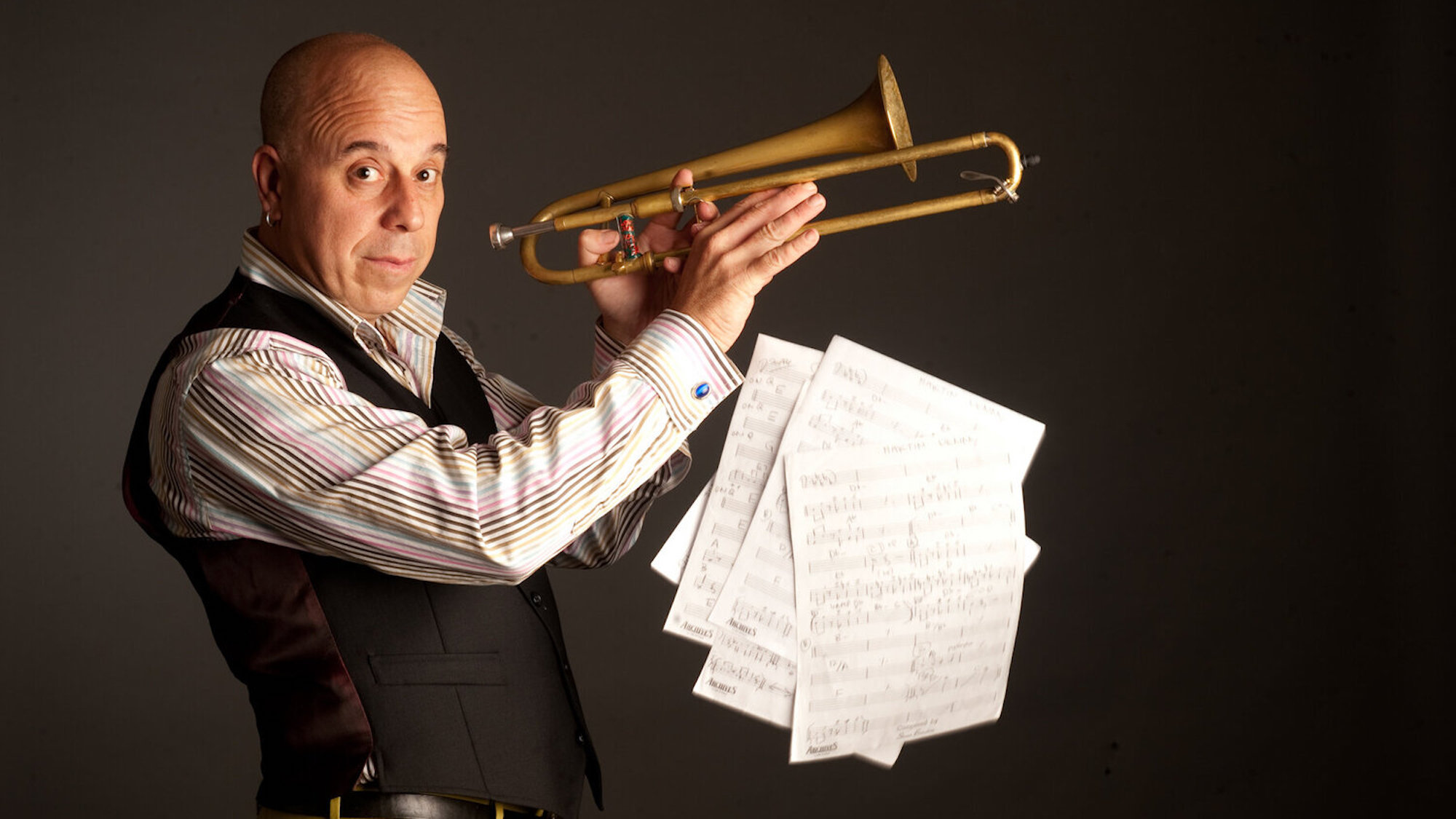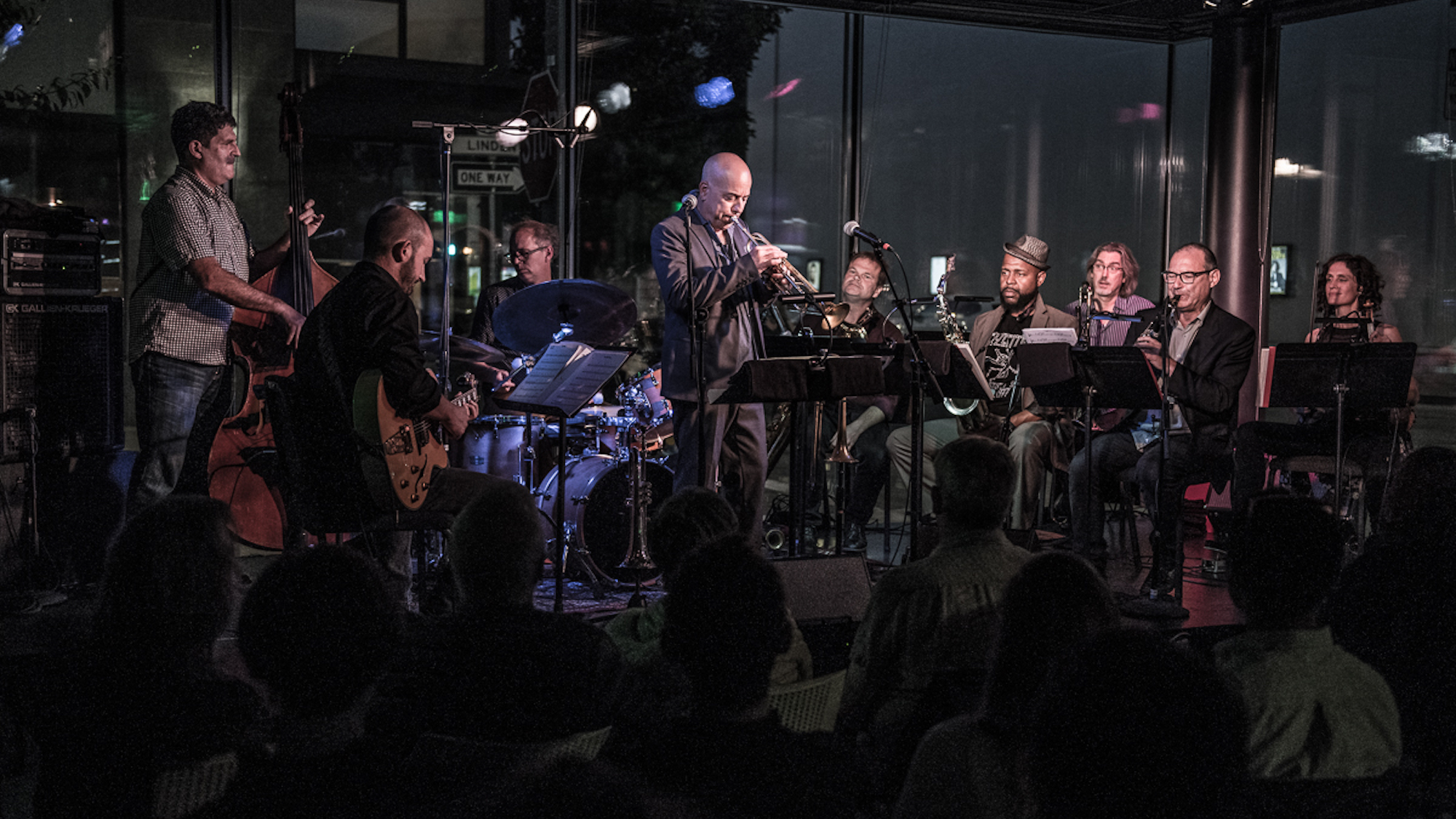February 13, 2024
No Boundaries: The Many Sides of Steven Bernstein
by Richard Scheinin
Slide trumpeter, composer, and bandleader Steven Bernstein returns (2/22-25) for two performances with his rollicking quartet Sexmob and his large ensemble Millenial Territory Orchestra West. In 2018, staff writer Richard Scheinin spoke to Bernstein about his career and musical approach.

Steven Bernstein, the slide trumpeter and bandleader, is a musician with a devil-may-care disposition. On any given night, he may play “Cry Baby Cry” or the theme from Goldfinger. In 2018, when U2 performed with members of Sun Ra’s Arkestra at the Apollo Theater in Harlem, who do you think got the call to arrange the charts? Correct. With Bernstein, one never can predict what the next project will be: “It’s like Spanky and Our Gang,” he says. “Come on kids, let’s put on a show!”
Bernstein is about to put on eight shows over the course of four nights (Feb. 22-25) at the SFJAZZ Center’s Joe Henderson Lab, a club-like room where the trumpeter’s freewheeling energy should carom off the walls. This birthday event celebrates Bernstein’s dynamism, presenting three iterations of his most compelling work as a leader. Nights one and two features his freewheeling band Sexmob, followed by two nights with the West Coast iteration of his Millennial Territory Orchestra. A nine-piece band that performs his arrangements of tunes by Prince, Sly Stone, Bennie Moten, Don Redman, Stevie Wonder and the Beatles, the MTO is just one of dozens of projects that he has imagined into being over a career that stretches back nearly 40 years: “I feel that one of my strongest skill sets is for organization – organizing groups and people,” he says. “You get ‘em together and you give ‘em some structure and you give ‘em the freedom to be incredible.”
Bernstein’s assault on musical decorum has taken him to some strange places: Who else could have thought up Spanish Fly, his trio for slide trumpet, tuba and steel guitar? Regardless of the lineup, his signature is to reach back to jazz’s beginnings – Louis Armstrong and Ellington are his favorite musicians – while overhauling pop tunes and putting on a show: “People who pick up a Sex Mob album are going to learn about Count Basie and Sun Ra by listening to an ABBA song,” he once said. “They may not know it at the time, but the next time they accidentally hear Sun Ra or Count Basie, they’re going to have a better understanding of what that music is. Or maybe they’ll search it out.”
One of my things is to just break down the barriers and make good music. Look, Lou Reed’s not here anymore. Henry Butler’s gone. Sam Rivers is gone. But I’m really lucky to have played with all my heroes. I kind of feel like it’s my time now. It’s my job – all our jobs – to be those people, to carry on that intent.
Over the years, Bernstein has performed with a million jazz luminaries – pianist Henry Butler, saxophonist Sam Rivers and trombonist Roswell Rudd are three of his favorites, all now passed – but also with Courtney Love, Lou Reed and Aretha Franklin. He spent eight years with Levon Helm’s Midnight Ramble Band and recently toured with Little Feat. He has arranged charts for dozens of artists, including Rufus Wainwright, Marianne Faithfull and Elton John. When film director Robert Altman needed a music director for Kansas City, which depicts the Midwest jazz scene of the 1930s, he hired Bernstein. When producer Hal Willner needed a music director for tributes to Leonard Cohen and Bill Withers, he called on Bernstein. A few years ago, Willner enlisted Bernstein yet again, this time for a project revolving around Bob Dylan’s 1963 solo concert at New York’s Town Hall. The trumpeter transcribed 21 songs from the recording of Dylan’s show, scored them for a 13-piece band, and led the performance at Town Hall in May: “We had all these amazing singers and comedians,” he says, “like Lisa Fischer, Bill Murray and Triumph the Insult Comic Dog.”
Asked to explain the extreme diversity of his musical life, he answers, “Our generation saw the reality of no boundaries.”

Born in 1961, Bernstein grew up in Berkeley, CA, and came of age during the 1970s, when the jazz mainstream and the avant-garde were seriously intermingled. He remembers buying an Ellington album called In A Mellotone and falling in love with trumpeters Rex Stewart and Cootie Williams. As a teenager, he also immersed himself in the subversive sounds of the era. At the Keystone Korner and other Bay Area clubs, Bernstein – often accompanied by his best friend, saxophonist Peter Apfelbaum saw Cecil Taylor, Don Cherry, Rahsaan Roland Kirk and the Art Ensemble of Chicago, whose trumpeter, Lester Bowie, could conjure Cootie Williams or Miles Davis with a single note, while also dipping into R&B, funk or total space music. He performed in a white lab technician’s coat: “When I grew up, jazz was cool, man!” says Bernstein, for whom Bowie offered a template – the avant-gardist with a sense of history and an entertainer’s know-how.
His trumpet teachers were hands-on musicians: John Coppolla played with Charlie Barnet, Woody Herman and Stan Kenton – and had open ears for Bowie. In 1977, when he was 15, Bernstein spent part of the summer in Woodstock, N.Y., at the Creative Music Studio, one of the era’s avant-garde laboratories. Wandering into a guitar shop in Woodstock, he came upon an old slide trumpet – fitted with a slide, in the manner of a trombone. Intrigued, he bought it for $25, a random decision that changed Bernstein’s musical life. Moving to New York City in 1979, he enrolled first in Columbia University and then in New York University, graduating in 1984. By that time, he says, “I was out every night, playing at Danceteria, the Mudd Club, the Ritz.” He knew John Zorn and got interested in “East Village punk, funk, rock kind of bands. And I’d go to see Fela (Kuti) and King Sunny Adé, all those bands that used to tour.” He followed a bunch of New York bands of the era – the Bush Tetras, Defunkt, Konk – and was into Talking Heads and Davie Bowie. “Those bands were cool, man, and they knew how to structure a show.”
When Bernstein began leading his own groups, he drew on those experiences as a way of bringing non-jazz audiences into his irreverent, often raucous and (though they may not have realized it) deeply jazz-informed performances. Sex Mob – setting Bernstein’s slide trumpet alongside saxophonist Briggan Krauss, bassist Tony Scherr and drummer Kenny Wollesen – may not have been the typical listener’s idea of a typical band. But Bernstein knew how to create access points: “The melodies have to be Sex Mob-able,” he explains, “whether it’s Stevie Wonder or Ellington or whatever it is. Like, when I came up with the Nino Rota idea, it was obvious – these are just really good melodies. And then you structure it in a way that people can recognize the songs: `Oh yeah! I know that one.’ And then we’ll go on this journey, and we may change moods. Hal Willner used to call it `needle drops,’ as if you’re dropping a needle in different places across a record album. We may start with one mood, but a second later we might do it like punk rock, or we might be in psychedelic land. I have my little cues for the band, and off we go.”

One thing leads to another. When Bernstein finished his work on the Kansas City film in the mid-‘90s, he says, “I still had all this music flying around my head.” He was deep into the lost world of pre-Kansas City swing — specifically, the Midwest territory bands that toured and recorded with unusual and impromptu instrumental combinations: “This was before things got codified, so a band could have three reeds or two reeds, maybe one trombone and sometimes they’d have fiddles. One band I heard had four violins, and then there’d be banjo or guitar. So I was listening to more and more of this stuff that I really liked and that we didn’t do in the movie, and the structure was really cool. Because it could seem like march music or early 20th century dance music. It wasn’t swing. It was this totally separate thing.”
His research led him to establish the Millennial Territory Orchestra as a way of rescuing this body of music, giving it new life. He mentions one of the tunes the MTO has played over the years: “Starvation Blues,” originally recorded by Jesse Stone and his Blue Serenaders for the OKeh label in 1927. And would you like to know something more about Jesse Stone, Bernstein asks? It turns out that Stone moved to New York, where he knew Ellington and Jimmy Lunceford and led bands at the Apollo Theater. He also joined the staff of Atlantic Records in the late 1940s as a producer, arranger and songwriter. In 1954, under the pseudonym of Charles E. Calhoun, Jesse Stone composed “Shake, Rattle and Roll.”
No boundaries.
Bernstein was always “a jazz musician genetically,” he says, “but I didn’t even call myself a jazz musician for the longest time. Now I do. But I don’t need that name. I’m going to do what I’m going to do.” That means performing at Manhattan’s Café Carlyle as bandleader for Gina Gershon, the actress and singer. It means mixing a live album by the Hot Nine, the group he co-led with Henry Butler, exploring early jazz repertoire by Jelly Roll Morton, Fats Waller and Ellington. It also means serving as co-artistic director of the Creative Music Studio in Woodstock, where he had those formative experiences in the 1970s.
It’s a slow process, he says, bringing the non-jazz world into the jazz fold, especially when so many jazz clubs cater to a white-linen clientele: “’We have a quiet policy and it’s $45 to hear an hour’s worth of music,’” he says, speaking in the voice of an imaginary club owner. “That’s what people associate jazz with. But one of my things is to just break down the barriers and make good music. Look, Lou Reed’s not here anymore. Henry Butler’s gone. Sam Rivers is gone. But I’m really lucky to have played with all my heroes. I kind of feel like it’s my time now. It’s my job — all our jobs — to be those people, to carry on that intent.”
Steven Bernstein performs with Sexmob (2/2-3) and Millennial Territory Orchestra West (2/24-25). Tickets and more information available here.
A staff writer at SFJAZZ, Richard Scheinin is a lifelong journalist. He was the San Jose Mercury News' classical music and jazz critic for more than a decade and has profiled scores of public figures, from Ike Turner to Tony La Russa and the Dalai Lama.
Originally posted 9/4/18, updated 2/13/24.
